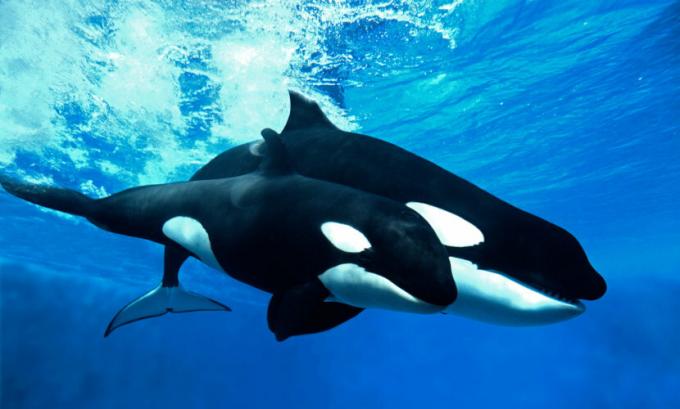dolphins they are mammals aquatic species belonging to the suborder of cetaceans. They are characterized by having a hydrodynamic body and forelimbs in the shape of oars. They are carnivorous animals and, depending on the species studied, feed on fish, molluscs and even from other mammals. Dolphins have an orientation system known as echolocation. Spinner dolphin and pink dolphin are dolphins that can be found in Brazil.
Read too:Blue whale - the biggest animal on the planet
Taxonomic classification of dolphins
Dolphins are animals belonging to theçlasse Mammalia, order Cetarthiodactyla and suborder Cetacea. Cetaceans can be grouped into two living groups: Mysticite and odontoceti. In the group of Mysticity, there are the true whales, which have horny fins in the shape of flexible blades in their mouths, replacing their teeth. In the group of odontoceti there are cetaceans with teeth, like dolphins. Cetaceans belonging to families are named dolphins.Delphinidae, Iniidae and Pontoporiidae.
General characteristics of dolphins

Dolphins are animals found in the aquatic environment, existing marine species and also in fresh water. As they live in an aquatic environment, they have characteristics that allow their survival in this environment, such as a hydrodynamically shaped body, oar-shaped forelimbs and hind limbs vestigial They have a thick layer of subcutaneous fat and have almost no hair. In some species, the mouth is elongated forward, forming a kind of long bill.
are animals that present breathing pulmonary, being, therefore, essential that they rise to the surface to be able to capture oxygen. Dolphins have a hole respiratorylocated in the region at the top of the skull that acts as a valve, opening when it reaches the surface and closing when it submerges. Dolphins have respiratory and circulatory systems adapted to withstand long periods underwater.
dolphins are carnivorous animals, feeding, for example, on fish and cephalopods. Some species, such as the orca, are able to feed on mammals such as seals and penguins.

dolphins are known for their great intelligence, showing proportionately large brains. According to the Spinner Dolphin Project, in relation to the animal's total weight and volume, the spinner dolphin's brain is the third largest, weighing about 1.5 kg, with the human brain being the sixth. If compared to the human brain, the dolphin's associative cortex region, part specialized in abstract and conceptual thinking, is larger.
Dolphin echolocation
Dolphins have a curious navigation system called echolocation. This system allows animals to capture echoes of the sounds they emit, identifying objects that are in the environment as they move around. Those sounds emitted are of high frequency and cannot be heard by human beings.
When these sounds hit an object, the echo returns to the dolphin, which picks them up through the jaw and ear. The information is transmitted to the brain, which will interpret the characteristics of that object, such as shape and texture, and its location.
dolphin species
As mentioned, the term dolphin is used to refer to animals belonging to three different families of cetaceans: Delphinidae, Iniidae and Pontoporiidae. This means that animals such as the orca and the Amazon porpoise are also considered dolphins. Next, we'll learn more about some species of dolphin:

-
Amazon porpoise, pink porpoise or red porpoise (Inia geoffrensis): is considered the largest freshwater dolphin in the world. It is found, in greater numbers, in the basins of the Amazon and Orinoco rivers. These animals have small eyes, a robust head that moves in several directions, an elongated snout and large pectoral fins.
The animal feeds mainly on fish. Males are more robust than females. The species is currently classified by the International Union for Conservation of Nature (IUCN) as “threatened”. If you want to know about the folk legend of this species, read: boto.
-
Orca (orcinus orca): contrary to what many people think, the orca is not truly a whale, despite being often called a “killer whale”. The species is part of the family Delphinidae. The orca has a high dorsal fin, its head is rounded, and has a characteristic black and white coloration. The male is larger than the female, reaching up to nine meters in length.
Killer whales feed on fish, turtles, seals, sea lions, among others. Interestingly, they present a number of tactics to be able to capture prey, including intentional stranding to capture animals such as seals and sea lions. Currently, according to the IUCN, data on the conservation of the species are insufficient.

-
Spinner dolphin (stenella longirostris): has this name for having the ability to jump and do stunts, being able to rotate several times on its own axis before returning to the water. It lives in groups of hundreds of individuals, being found in tropical and subtropical waters of all types. oceans.
It has a hydrodynamic body and an elongated, thin rostrum. It has an average length of around 1.80 m and weight around 78 kg. These animals feed on fish, shrimp and squid. They are currently classified by the IUCN in the “Least Concern” category.



